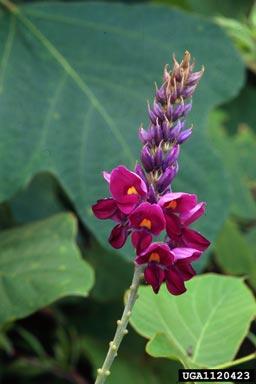 [S]
[S]
KUDZU, AN INVASIVE PLANT
by Grandpa Cliff Nov 10, 2005 (revised Jan 3, 2006)
 [S]
[S]
Kudzu flowers (Pueraria montana)
KUDZU (CUD-zoo) is a drought-resistant perennial plant that was brought to the U.S. from Asia in 1876 to be used as an ornamental plant and grown in fields for grazing cattle to eat. From 1935-1953, the federal government encouraged farmers to grow Kudzu to prevent soil erosion. For part or all of that period, the farmers were paid to plant Kudzu. More than 73 million seedlings were distributed between 1935 and 1941. Then, in the 1950s it was recognized that Kudzu was a pest plant.
Cattle and other animals liked to eat Kudzu, but grazing cattle trampled the spreading vine tips so that they did not grow well. Farmers also learned that Kudzu, unlike hay, was difficult to bale. For these two reasons, Kudzu turned out not to be a good crop to grow as feed for farm animals.
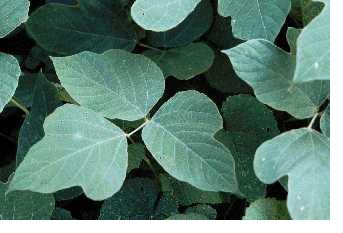 A Kudzu leaf (left) has three
leaflets. Often the leaflets have no teeth or lobes, but at other times
they resemble Poison Ivy as in the photo. The young leaves of Kudzu can be
used by humans for salad or cooked as a leafy vegetable. However, care
must be taken to avoid picking any Poison Ivy that might grow with Kudzu.
The two plants can be told apart, because Kudzu has hairy leaf petioles and Poison Ivy does
not. See my pictorial webpage about Poison
Ivy.
A Kudzu leaf (left) has three
leaflets. Often the leaflets have no teeth or lobes, but at other times
they resemble Poison Ivy as in the photo. The young leaves of Kudzu can be
used by humans for salad or cooked as a leafy vegetable. However, care
must be taken to avoid picking any Poison Ivy that might grow with Kudzu.
The two plants can be told apart, because Kudzu has hairy leaf petioles and Poison Ivy does
not. See my pictorial webpage about Poison
Ivy.
[S]
Leaflets have the ability to move. They can face the sun to maximize photosynthesis, or face away from the sun to reduce their temperature and also cut down on water loss (by transpiration) in dry times.
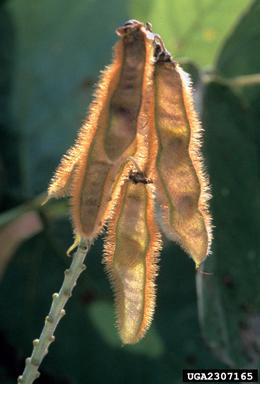
Kudzu plants do not usually flower until their third year. Flowers only rarely appear on the horizontal vines that grow along the ground. They produce no seeds.
Climbing vines produce hairy fruits (see pods on left). In North America, a pod cluster will only produce one or two seeds that can germinate and grow. And seed production is quite limited outside the Southeastern U.S. Seeds do not sprout well because water has such a difficult time getting through the seedcoat.
The absence of abundant seeds keeps the Kudzu from spreading rapidly to new locations. Once a plant is established, however, in North America an unexpectedly vigorous growth can occur.
The root of the Kudzu vine is a taproot (so are carrots and beets) which can be up to 7 inches wide and six feet long, weighing as much as 400 pounds.
[S]
Vines can grow a foot per day during the growing season and get as long as 100 feet. Growth is over three times as great on sunny days as compared with overcast days. It has a high light requirement and dislikes shade. Kudzu does best where the growing season is long, the summer temperatures are above 80 degrees F, the winters are mild (40-60 F), and the annual precipitation is greater than 40 inches. Because Kudzu is a nitrogen-fixing plant, it can outcompete most other plants in soils which lack nitrogen. It is a legume like peas and beans (family Fabaceae). The flowers and fruits are similar to those of the pea plant.
Rooting usually occurs every few feet along the horizontal stems, and new root crowns develop at those places. The following spring, vines are sent out in all directions from each root crown. As many as 30 vines can grow from one root.
With this potential for growth, the photo at the left [S] should be no surprise. The Kudzu vines have completely covered the ground and also many of the trees in the background. They smother everything, blocking out the sunlight to other plants causing them to die.
The hills in the aerial photograph below have been completely covered. [S]
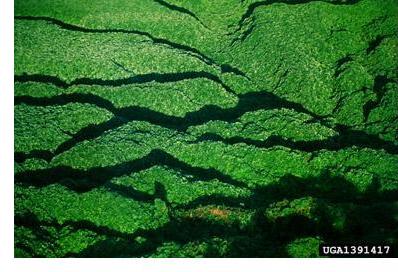
In northern states, the horizontal vines in the open die back to the root crown after the first frost, but the root crowns survive. Each root crown would act like a new plant the following spring.
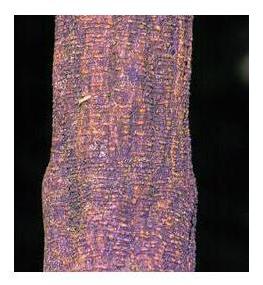
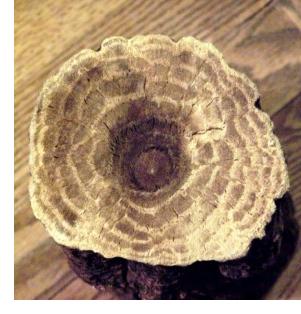
Kudzu's vertical vines which grow up trees (left & right) can grow to a diameter of 4 inches (the size of a 2-liter bottle of soda). That is much larger and heavier than the horizontal vines. The frost does not kill it, so it adds annual rings over the years. The cross-section on the right, collected Nov 2004 in the Bronx (New York City), shows eight years of growth.
[S]
[Grandpa Cliff]
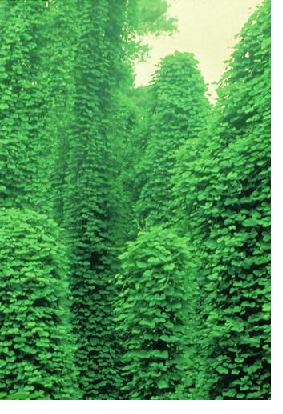
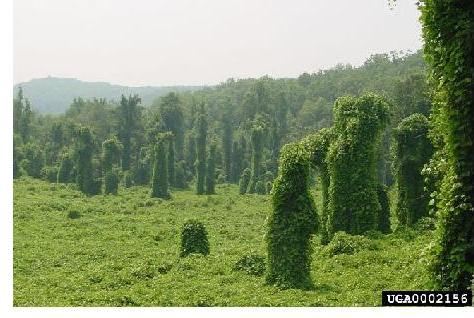
When the climbing vines grow up trees, their extreme weight can cause all of the branches to break off, leaving only the trunk. Notice that the trees (photos left & right) have been overgrown and are missing their side branches. Sometimes the weight of Kudzu will even topple a tree and uproot it.
[S]
[S]
 [S]
[S]
This automobile was no match for Kudzu.
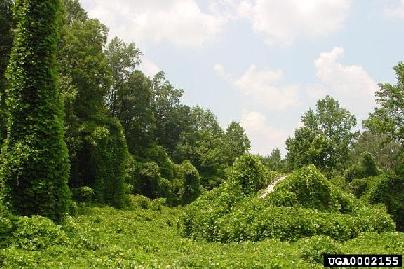 [S]
[S]
This small abandonded house has been overgrown, including the chimney in the rear.
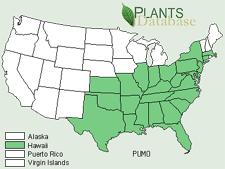
The map shows the U.S. states in which Kudzu (Pueraria montana) could be found in
2003.
[S]
Kudzu versus Man
Can Kudzu be controlled? After it overran 10 acres of the Vicksburg National Military Park in Mississippi, measures were taken to eradicate (kill) it with approved herbicides (plant killers). Their website shows five photos of the same scene over a period of time. At first it was overgrown with Kudzu, then the plants were killed, then they were burned, then grass was planted, and finally the grass grew tall. View the photos.
Why is Kudzu such a problem in the U.S.? Read my Plant and Animal Invaders which gives information that explains why these and other invasive species can do so well once they get to a new continent.
Kudzu isn't all bad. "Much to the surprise of those who must battle the vine, kudzu has a fine reputation in Japan, where it has been used for centuries in medicines and in foods. Processed into a powdered starch, kudzu root is prized as a thickening agent and as an ingredient in Eastern herbal remedies." "For human consumption, all parts of the high-fiber, low sodium plant are edible. Select young shoots and leaves, which are more tender than mature parts, and wash thoroughly. Foragers should avoid roadsides, railroads and other locations where herbicides might be the preferred treatment for kudzu control... Those interested in kudzu cookery can find recipes in Japanese cookbooks." [S]
------------------------------------------------------------------------------------------------------
See 107 photos of Kudzu.
Visitors since 24
Nov 2005
Go to the HOME page